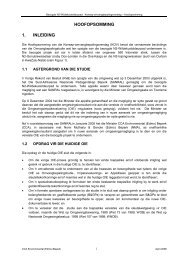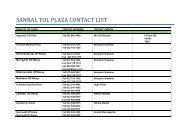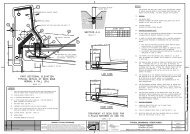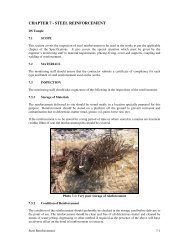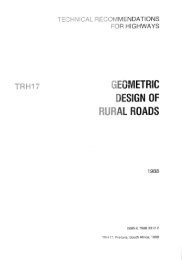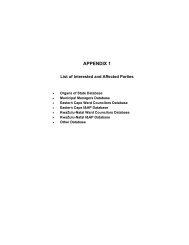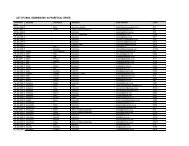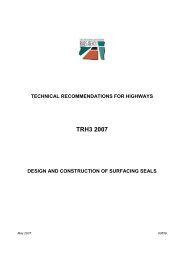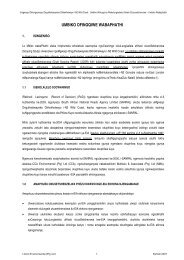SAPEM Chapter 2 - Sanral
SAPEM Chapter 2 - Sanral
SAPEM Chapter 2 - Sanral
Create successful ePaper yourself
Turn your PDF publications into a flip-book with our unique Google optimized e-Paper software.
South African Pavement Engineering Manual<br />
<strong>Chapter</strong> 2: Pavement Composition and Behaviour<br />
9. MECHANICS OF MATERIALS (STRESSES AND STRAINS)<br />
To understand how pavements and materials behave, and how they are typically<br />
modelled, it is necessary to grasp the concepts of stress and strain in materials.<br />
This section discusses these concepts, and their application to pavement<br />
engineering.<br />
9.1 Definitions of Stress and Strain<br />
Units for Stress<br />
We typically use the unit<br />
kPa for tyre pressure and<br />
MPa for stiffness.<br />
Consider an element of material, with an original length L as shown in Figure 19<br />
with a normal tensile force F applied to it. The force F divided by the cross-sectional area A is defined as the stress<br />
called sigma (), as shown in Equation (2).<br />
Figure 19. Force Applied to an Element of Material<br />
Stress<br />
F<br />
<br />
A<br />
(N/m 2 or Pascal) (2)<br />
The units of stress are the same as for pressure. In other words, the element of material is experiencing an internal<br />
“pressure” when a force is applied to it. Normal stresses can either be tensile, causing extension, or compressive,<br />
causing shortening of the element. In the example in Figure 19, the material is subjected to a tensile stress.<br />
The applied stress will result in some elongation of the block. In this case, the total elongation is L. This elongation<br />
is represented as strain , called epsilon, which is defined as the unit linear change in length, and is calculated in the<br />
manner shown in Equation (3). Strain is dimensionless. Sometimes microstrain, = 10 -6 is used as a<br />
dimensionless unit for strain, because this gives more understandable and manageable values.<br />
Strain<br />
L<br />
<br />
L<br />
(3)<br />
9.2 Normal and Shear Stresses and Strains<br />
The definitions of stress and strain were limited to one-dimension. Materials, however, exist in three dimensions.<br />
Imagine a small cube of material, subjected to stresses at any point within a pavement structure, as illustrated in<br />
Figure 20 with a Cartesian x-y-z coordinate system. The figure illustrates stresses, but the definitions and discussion<br />
are also relevant for strains. Normal stresses are defined as the stresses that act perpendicular to a particular face of<br />
the cube. For example, the stress acting in the z-direction, perpendicular to the z-face (the face perpendicular to the<br />
direction, in the x-y plane) is called zz . Similarly, xx and yy are the other normal stresses. Normal stresses can be<br />
both tensile and compressive.<br />
The stresses that act parallel to a face are called shear stresses. For example, zy, is the shear stress acting on the z-<br />
plane in the y direction. Normal stresses invoke volume changes in the cube, whereas shear stresses invoke shape<br />
changes, as illustrated in Figure 21. Generally however, normal and shear stresses act on a material simultaneously,<br />
invoking both volume and shape changes.<br />
In total, there are 3 normal stresses and 6 shear stresses that are needed to quantify the stress state. The value of<br />
each of these 9 stresses depends on the chosen coordinate system. Fortunately, it is always possible to rotate the<br />
cube until a position is reached where there are no shear stresses, and only normal stresses. This rotated position is<br />
known as the principal axes, and the normal stresses are the principal stresses. In the principal axes space, the<br />
Section 9: Mechanics of Materials (Stresses and Strains)<br />
Page 24





